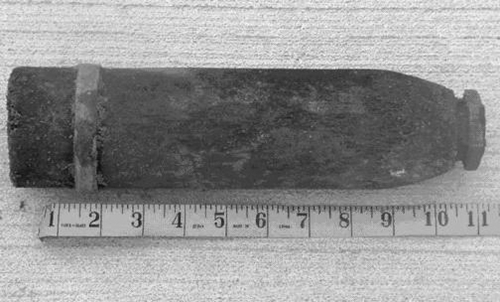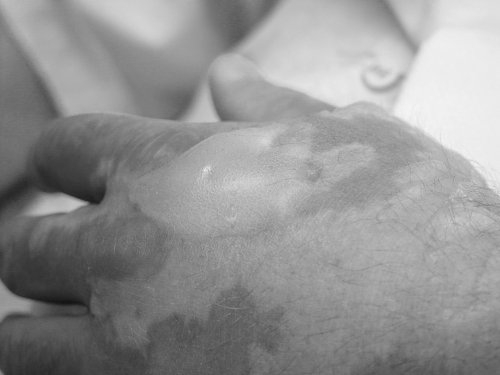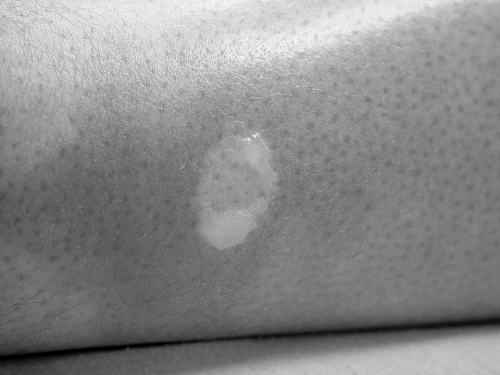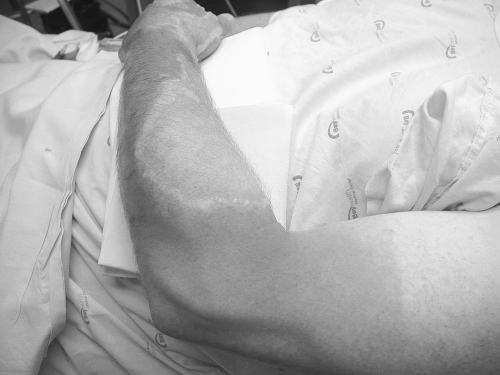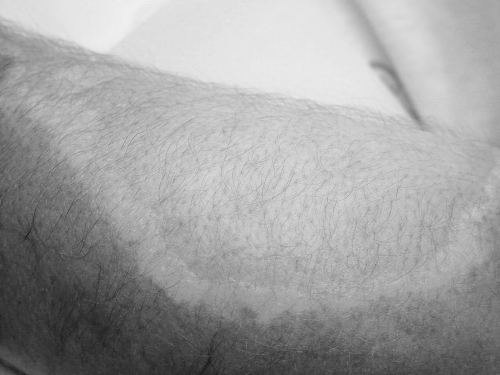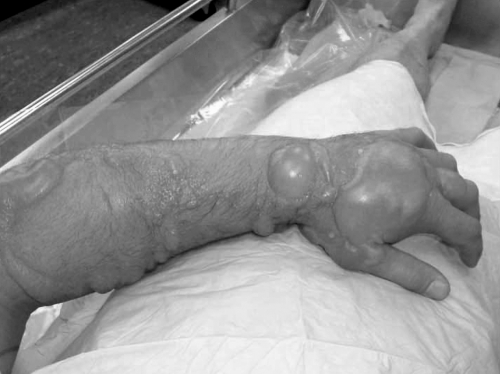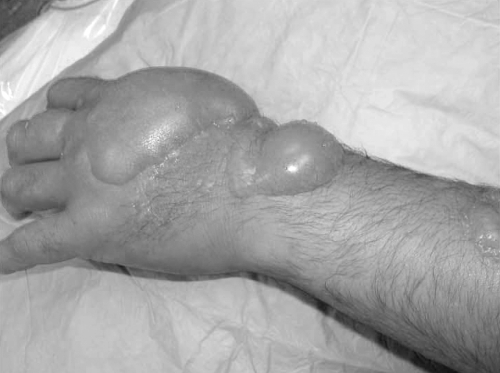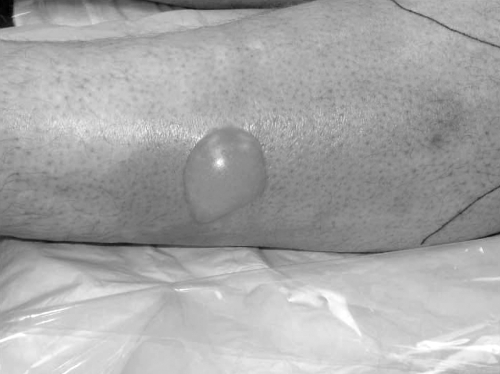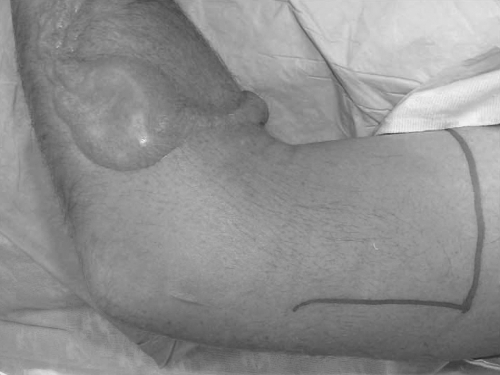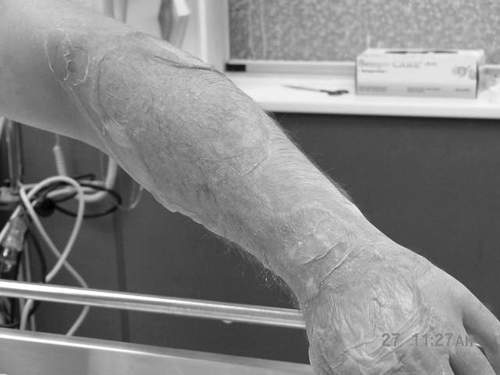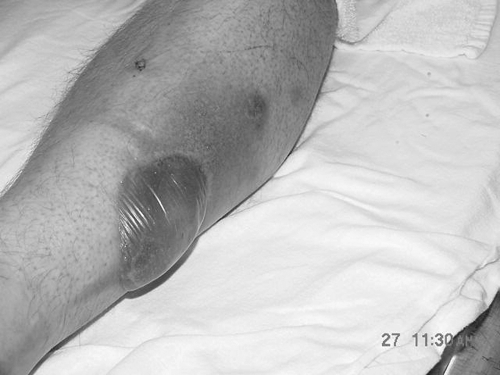Abstract
Sulfur mustards act as vesicants and alkylating agents. They have been used as chemical warfare since 1917 during the first world war. This brief report illustrates the progression of injury on a primary exposed patient to a first world war blistering agent. This case documents the rapid timeline and progression of symptoms. It emphasises the importance of appropriate personal protective equipment and immediate medical response plan with rapid decontamination and proper action from military and civilian medical treatment facilities. This case reports the first US active duty military exposure to a blistering agent in the age of global terrorism.
Keywords: vesicant, sulfur mustard, mustard gas, blistering agent, decontamination
Clinical summary
History
A 35 year old US military male presented with burns 15 hours following the destruction of a first world war ordinance (fig 1). The patient noted an intense chemical odour and an oily black liquid leaking from the ordinance upon its destruction; this substance dripped onto the patient's left hand/forearm and left boot. Approximately 11 hours after exposure, he awoke with pain in his left arm and noted blisters. Upon initial evaluation at a civilian emergency department, erythema was observed on his left forearm with an associated bulla on the dorsum of his hand; he rapidly developed worsening erythema and vesicles on the affected forearm over the next three hours. After 24 hours, the vesicles and bullae enlarged significantly.
Figure 1 First world war ordinance with blistering agent.
Physical examination
On the initial evaluation, physical examination confirmed left upper arm and lower extremity erythema and a 4–5 cm blister eruption involving the dorsum of the left hand, a smaller 1 cm blister eruption involving the dorsum of the left foot, and a 2 cm blister eruption involving the lateral distal leg (figs 2–5). There were areas of pallor around the exposure area. There was surrounding erythema extending up to the arm. There was no involvement of the ears, neck, axillae, shoulders, groin, or knees. There was no lymphadenopathy. There was no upper or lower extremity swelling. There were no singed hairs on nasal examination and oropharynx was clear. Lungs were clear to auscultation.
Figure 2 Left hand post exposure day one to blistering agent with erythema and blister.
Figure 3 Left lateral distal leg post exposure day one to blistering agent with erythema and blister.
Figure 4 Left arm post exposure day one to blistering agent with erythema and central area of pallor.
Figure 5 Left arm post exposure day one to blistering agent with erythema and central area of pallor, closer view.
Subsequent examinations on post exposure day two show rapid progression of erythema and enlargement of blisters over the dorsum of the left hand, left elbow, dorsum of the left foot, and left distal lateral leg. He was noted to have chemical burns over 6.5% of his body (figs 6–9).
Figure 6 Left arm post exposure day two to blistering agent with erythema and enlarging blister.
Figure 7 Left hand post exposure day two to blistering agent with erythema and enlarging blister.
Figure 8 Left lateral leg post exposure day two to blistering agent with erythema and enlarging blister.
Figure 9 Left arm post exposure day two to blistering agent with erythema and enlarging blister.
Subsequent examinations on post exposure day six showed improving erythema and sloughing and decreasing size of blisters over the dorsum of the left hand, left elbow, dorsum of the left foot, and left distal lateral leg (figs 10 and 11).
Figure 10 Left arm post exposure day seven to blistering agent with improved erythema and sloughing blister.
Figure 11 Left lateral leg post exposure day seven to blistering agent with improving erythema and improving blister.
Laboratory data
Electrolytes showed sodium 135 mmol/L, potassium 4.6 mmol/L, blood urea nitrogen 11 mg/dl, creatinine 1.2 mg/dl, chloride 103 mmol/L, carbon dioxide 25.5 mmol/L. Complete blood count was significant for leucocytosis; white blood count 12.8 K/UL, haemoglobin 16.4 gm/dL, haematocrit 47.0%, platelet 183 K/UL. Differential count of blood showed lymphocytes 3.1 K/mm3 (34.1%), monocytes 0.6 K/mm3 (6.88%), granulocytes 5.1 K/mm3 (55.3%), eosinophils 0.3 K/mm3 (2.82%), basophils 0.1 K/mm3 (0.895%.). A chest x ray was unremarkable. To confirm sulfur mustard exposure, the blood, aspirate of blisters, and urine were examined for by‐products of vesicant agent by US Army Medical Research Institute of Chemical Defense (USAMRICD). Analysis of the patient's blister fluid and urine confirmed detection of sulfur by‐products, suggesting contact with sulfur mustard. A detailed report of these findings with accuracy and precision of assay is pending submission to another journal.
Management
The patient was originally assessed at a local civilian emergency room by a military physician. Copious irrigation was used to decontaminate the exposed areas of his arm. He was noted to have chemical burns over 6.5% of his body. He was transferred to a university burn centre because of the progression of blisters. At the burn unit he underwent daily cleansing of skin, debridement of eschar, as well as application of antibiotic ointments. His blood counts and electrolytes were monitored on a daily basis and remained constant over the course of his hospital admission. He was evaluated by a nutritionist, physical therapist, occupational therapist for overall health maintenance, and an ophthalmologist to rule out ocular involvement. Member was discharged 10 days after the initial exposure without further complications. He continues to see the military clinic for long term follow up to evaluate his blood and lungs for possible bone marrow suppression and respiratory dysfunction as long term complications.
Discussion
Sulfur mustards are classified as vesicants and alkylating agents. They were developed first in the early or mid 1800s and were used as chemical warfare agents in 1917 during the first world war.1 They remain a major threat even today. At least 12 nations still have sulfur mustards in their chemical weapon arsenal. The US is currently in the process of destroying stockpiles of chemical agents, including sulfur agents as mandated by Chemical Weapons Convention. The disposal of these types of weapons is scheduled to take place before April 2007.2
The chemical classifications are (H), which contain 20–30% impurities, (HD), which is distilled mustard and is nearly pure, and (HT), which is 60% HD and 40% agent T. The agent T is bis(2‐chloroethylthioethyl) ether. Agent T is described as a “higher mustard” and was said to be three times as active a vesicant as sulfur mustard.5 The sulfur mustard is colourless when pure and pale yellow, dark brown, or black oily liquid. The vapour is colourless. In solution, sulfur mustard agents hydrolyse to form hydrochloric acid and thiodiglycol.2 For diagnostic testing, to confirm sulfur mustard exposure, the by‐products can be detected in urine up to two weeks following exposure. The USAMRICD is developing a blood, blister aspirate, and urine assay to detect thiodiglycol in primary exposed patients with blister symptoms.6
The possible routes of exposure include inhalation, skin or eye contact, and ingestion. Direct contact with skin can cause cell damage and blistering. Symptoms are usually delayed and take 2–24 hours to develop. Vapour contact to skin can cause second degree chemical burns. Liquid contact to skin can cause second to third degree chemical burns. Eyes are the most sensitive and can cause pain, swelling, and photophobia. Inhalational injury can occur because sulfur mustards are readily absorbed from the respiratory tract and develop slowly and intensifies over days. There is no antidote for sulfur mustard poisoning and the treatment is mainly supportive.3 An important note is that the role of personal protective equipment could have been vital in preventing this particular exposure to mustard and should be emphasised under all circumstances and threats.
Chemical burns secondary to vesicant exposure appear deceptively superficial on first presentation. The early signs and symptoms of possible contamination are pruritis and burning pain over the areas that were exposed. As the burn progresses, erythema develops and is followed by the formation of superficial bulllae. Treatment measures of blisters are supportive. Strategies of dermabrasion versus laser debridement have been introduced as promising advances. Despite comprehensive studies, there has been little recommended to manage the skin burns of mustard gas except for necessary skin grafts.1
It is well documented that immediate decontamination can reduce symptoms. Exposure to sulfur mustard is not fatal. When it was used during the first world war it caused fewer than 5% mortality of the people who were exposed and got proper medical care.2
Decontamination is a valuable treatment to prevent tissue damage if performed in the first few minutes after exposure.4 To promote healing and prevent infection, cleansing of skin, debridement of eschar, as well as application of antibiotic ointments should be performed. Some studies state that the vesicular lesions should be opened to drain to prevent solidification that could impede healing.3
From this case report, it is recommended that civilian and military institutions actively review the latest information on the management of chemical agent exposures. In the age of global terrorism, with the continued threat of vesicants and other types of chemical or biological warfare, all medical facilities need to focus on training and exercising response to potential materials to include self assessments, gathering a complete collection of reference materials, and actively exercise/role play or provide training courses for physicians, nurses, and first responders. Early decontamination and recognition of potential agents may decrease morbidity and mortality of a primary exposed patient. As this case study demonstrates, the contact with a blistering agent can cause rapid clinical changes and the exposure should be quickly identified and managed with irrigation, debridement, antibiotics, and grafting if warranted.4
Acknowledgements
Acknowledgments are made to the 436th Medical Group at Dover Air Force Base, Temple University Hospital Burn Unit, U.S. Army Medical Research Institute of Chemical Defence (USAMRICD) at Aberdeen Proving Ground.
Abbreviations
H - sulfur mustard
HD - distilled sulfur mustard
HT - combination sulfur mustard
USAMRICD - US Army Medical Research Institute of Chemical Defense
Footnotes
Competing interests: none declared
Ethical approval: written consent from the patient has been obtained before publication of this article.
References
- 1.Rice P. Sulphur mustard injuries of the skin. Pathophysiology and management. Toxicol Rev 200322(2)111–118. [DOI] [PubMed] [Google Scholar]
- 2.U.S. Army Medical Research Institute of Chemical Defense (USAMRICD) Interim Guidance on Occupational Health Practices for the Evaluation and Control of Occupational Exposures to Mustard Agents. DOD publication. July 2000, 3rd edition
- 3.Ruhl C M, Park S J, Danisa O.et al A serious skin sulfur mustard burn from an artillery shell. J Emerg Med 199412(2)159–166. [DOI] [PubMed] [Google Scholar]
- 4.Papermeister B, Feister A J, Robinson S I.et al Medical defense against mustard gas: toxic mechanisms and pharmacological implications. Boca Raton, FL: CRC Press, 1991
- 5.Read R W, Black R M. Analysis of sulfur mustard metabolite 1,1′‐sulfonylbis [2‐S‐(N‐acetylcysteinyl)ethane] in urine by negative ion electrospray liquid chromatography‐ tandem mass spectrometry. J Anal Toxicol 28(5)352–356. [DOI] [PubMed] [Google Scholar]
- 6.Capacio B R, Smith J R, DeLion M T.et al Monitoring sulfur mustard exposure by gas chromatography‐mass spectrometry analysis of thiodiglycol cleaved from blood proteins. J Anal Toxicol 200428(5)306–310. [DOI] [PubMed] [Google Scholar]



